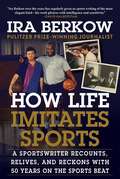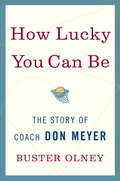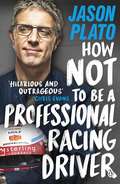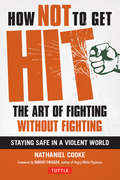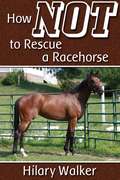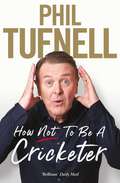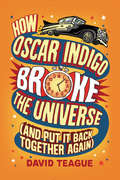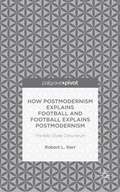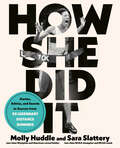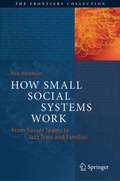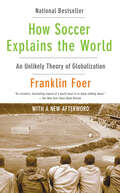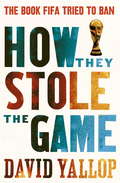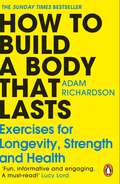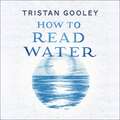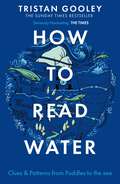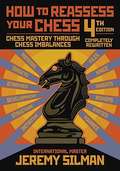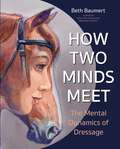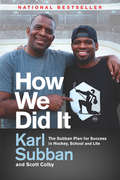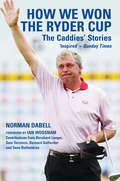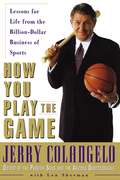- Table View
- List View
How Life Imitates Sports: A Sportswriter Recounts, Relives, and Reckons with 50 Years on the Sports Beat
by Ira BerkowMemorable Stories From a Half Century of Sports Journalism For the last half century, Pulitzer Prize–winning sportswriter Ira Berkow has been at the center of some of the most memorable moments in sports history. From the World Series, NBA Finals, and Super Bowl, to Heavyweight Title Fights, the Olympics, and The Masters, he has seen and covered them all. After fifty years covering sports, with more than twenty-five as a journalist for the New York Times, How Life Imitates Sports shares how these events—and their participants—have significantly shaped how we as a nation have come to understand and perceive our culture (and even our politics). They are a historical record of one significant sphere of our life and times: sports. From Muhammad Ali to Mike Tyson, Michael Jordan to LeBron James, Jackie Robinson to Derek Jeter, Billie Jean King to Tonya Harding, O. J. Simpson to Tiger Woods and beyond, this collection is a historical record of our times over this past half century, in terms of society, race and gender, politics, legal issues, and the fabric of our sports passions and human condition, ranging from pathos to humor, from introspection to perception. Including additional commentary on when these events first occurred and how they have impacted us today, Berkow shares the knowledge of someone who sat ringside, in the press box, and on the sidelines for some of the most notable moments in our history. So whether you&’re a fan of baseball and basketball, or tennis and soccer, How Life Imitates Sports shows you our history from someone who witnessed it first-hand; a worthy collection for anyone who appreciates the highest quality sports journalism.
How Lucky You Can Be: The Story of Coach Don Meyer
by Buster OlneyIn September 2008, Northern State University men#x19;s basketball coach Don Meyer stood on the brink of immortality. He was about to surpass the legendary Bobby Knight to become the all-time NCAA wins leader in men#x19;s basketball. Then, on a two-lane road in South Dakota, everything changed in an instant. InHow Lucky You Can Be, acclaimed sports journalist Buster Olney tells the remarkable story of the successive tragedies that befell Coach Meyer but could not defeat him. Laid low by a horrific car accident that led to the amputation of his left leg below the knee, Coach Meyer had barely emerged from surgery when his doctors informed him that he also had terminal cancer. In the blink of an eye, this prototypical 24/7 workaholic coach-who arrived at the gym most mornings before 6 a. m. -found himself forced to reexamine his priorities at the age of sixty-three. A model of reserve, Coach Meyer had sacrificed much of his emotional life to his program. His wife, Carmen, felt disconnected because of his habitual reticence, while his three children-all now well into adulthood-had long had to compete with basketball for his attention. With sensitivity and skill, Olney shows how Coach Meyer mined his physical ordeal for the spiritual strength to transform his life. In the months that followed his accident and diagnosis, he reached out to family, friends, and former players in a way he had never been able to do before, making the most of this one last opportunity to tell those close to him how he felt about them-and in turn he received an outpouring of affirmation that confirmed how deeply he had affected others. Sustained throughout an often painful recovery by his love of basketball, he would return to the court once more-with a newfound appreciation for the game#x19;s place in his life. The inspirational story of a life renewed by unimaginable hardship,How Lucky You Can Beproves that it#x19;s never too late to start making changes-and reminds us that fortune can smile upon us even in our most trying hours. From the Hardcover edition.
How Mechanics Shaped the Modern World: A Contextual Introduction to Concepts and Applications
by David H. AllenThis updated and augmented second edition covers the history of mechanics in such a way as to explain how this all-important discipline shaped our world. Like the first edition, Dr. Allen presents the material in an engaging, accessible manner, with many historic insights and thorough explanations of attending concepts. The text retains its coverage of classical mechanics, essentially Newtonian mechanics, and adds chapters on three additional topics that go well beyond classical mechanics: relativity, quantum/nanomechanics, and biomechanics.
How Not to Be a Professional Racing Driver
by Jason Plato'HILARIOUS AND OUTRAGEOUS' CHRIS EVANS THE HILARIOUS FULL-THROTTLE MEMOIR FROM ONE OF THE BIGGEST CHARACTERS IN UK MOTOR RACINGSHORTLISTED FOR THE TELEGRAPH SPORTS BOOK AWARDS 2020 Two-time championship-winning and record-breaking racing driver, Jason Plato is a living, breathing example of what you shouldn't do if you want to become a professional racing driver: DO NOT: · Steal a JCB in Monaco and end up in prison there - twice · Kill Bernie Ecclestone (almost) · Choose fags and booze over the gym · Give Prince Charles the finger on the M42 · Make enemies with a 6ft 6" rival who is a black belt in everything Since joining the Williams Touring Car team in 1997 he has had more race wins than Lewis Hamilton and Stirling Moss, competed in more races than Jenson Button and set the largest number of fastest laps ever. But he's also a rule breaker who has had more than his fair share of near-death experiences, drunken escapades and more. There is nothing sensible, predictable or considered about Jason.But this is how he became a racing legend. ______ LONGLISTED FOR THE TELEGRAPH SPORTS BOOK OF THE YEAR AUTOBIOGRAPHY AWARD 'As entertaining as watching him drive, a cracking read!' Sir Chris Hoy 'Jason Plato is one of the most gifted racing drivers of his generation!' Damon Hill
How Not to Get Hit
by Robert Twigger Nathaniel CookeThe average person isn't looking to be in a situation where fists are going to fly, but many of us have found ourselves there anyway. At that moment, it's probably too late to do anything about it. But how do we change circumstances so those situations don't happen? How Not to Get Hit is a book on personal safety for people who don't want to learn to fight, but do want to learn how to avoid those situations where a fight is likely to develop.Told in a lighthearted, irreverent style, How Not to Get Hit takes you on a journey through the funny side of violence, its roots in our evolutionary past and where it fits in to modern society. Self defense isn't a series of techniques or moves, it's an attitude, a strategy and a life skill. This book will give you an understanding of why people want to use violence, how they will use it and using this knowledge to manage situations and create a better outcome.
How Not to Get Hit
by Robert Twigger Nathaniel CookeThe average person isn't looking to be in a situation where fists are going to fly, but many of us have found ourselves there anyway. At that moment, it's probably too late to do anything about it. But how do we change circumstances so those situations don't happen? How Not to Get Hit is a book on personal safety for people who don't want to learn to fight, but do want to learn how to avoid those situations where a fight is likely to develop.Told in a lighthearted, irreverent style, How Not to Get Hit takes you on a journey through the funny side of violence, its roots in our evolutionary past and where it fits in to modern society. Self defense isn't a series of techniques or moves, it's an attitude, a strategy and a life skill. This book will give you an understanding of why people want to use violence, how they will use it and using this knowledge to manage situations and create a better outcome.
How Not to Rescue a Racehorse
by Hilary WalkerWhen my current dressage horse wants a change in career, I visit Nonette, a beautiful wannabe-retired racehorse at the track with great dressage potential. I find her stuck in a dark, hot stall.I have no room for her at home and have promised my husband I won’t buy another horse until I sell the one I already have.But poor Nonette! Having seen the conditions in which she lives, I feel obliged to rescue her. However, my husband mustn’t find out what I’m doing -- he’ll never believe I don’t intend to keep another horse.Read on to discover how rescuing the pretty mare becomes a nightmare!
How Not to be a Cricketer
by Phil TufnellIn How Not to be a Cricketer, former England international and TV personality Phil Tufnell highlights the many potential pitfalls of a professional cricket career, and provides a hilarious insight into how to avoid them and what happens when, like him, you don't. I was the model cricketer – if anyone wanted to know how not to be one. My career included more ups and downs than the big dipper at Margate and more bumps than the dodgems next door. And yet somehow I climbed off the ride unblemished. I survived to walk away on my own terms. For someone who never quite fitted the mould, I was actually pretty good at not being a cricketer. In his superb new book, Phil Tufnell looks back over his life and career to provide brilliant advice and insights, often learned the hard way, from his own experiences as a cricketer. If you want to learn how to make a good first impression, maybe don&’t have your hair cut in a Mohican. And when, after a drunken night on an England Under-19 tour to Barbados, the players were told &‘You cannot be caught coming in at a ridiculous hour and still be drunk in the morning&’ most took his wise words on board; Tuffers vowed not to get caught. Packed with brilliant stories and revealing anecdotes about some of the great players of his time, such as Mike Atherton, Mike Gatting, Graham Gooch and Nasser Hussain, How Not to be a Cricketer is the perfect read for anyone who wants to know more about the potential pitfalls of the game, and how to avoid them.
How Oscar Indigo Broke the Universe (And Put It Back Together Again)
by David Teague★ "Suspend all disbelief and enjoy." —Kirkus (starred review)From David Teague, the coauthor of the critically acclaimed Saving Lucas Biggs, comes a funny and sweet story about learning to have courage even when it feels like the world is ending.Oscar Indigo has never been good at baseball, so naturally he’s nervous when he has to fill in for his team’s injured All-Star, Lourdes. Luckily, Oscar has a mysterious gold watch that can stop time, which he uses to fake a game-winning home run. Now Oscar’s the underdog hero of his town and even Lourdes wants to be his friend. But the universe is a precarious place, and you can’t just steal time without any consequences. If Oscar doesn’t find a way to return the time he stole, the universe will unwind completely. Oscar wants nothing more than to ask Lourdes for help, but what would a baseball star like her think of a guy whose fake home run actually destroyed the universe? But as he and Lourdes grow closer, Oscar understands that it isn’t always what you do that makes you special—but who you are. And that confidence just might be the key to fixing the universe.
How Postmodernism Explains Football and Football Explains Postmodernism: The Billy Clyde Conundrum
by Robert KerrAmerican football and postmodernist theory are both objects of popular and scholarly interest that reveal remarkable sociological insights. Analysis of media-driven commercial football documents how narratives of sportsmanship/brutality, heroism/antiheroism, athleticism/self-indulgence, honor/chicanery, and chivalry/sexism compete and thrive.
How She Did It: Stories, Advice, and Secrets to Success from Fifty Legendary Distance Runners
by Molly Huddle Sara SlatteryThe ultimate roadmap for female distance runners, from two-time Olympian Molly Huddle and two-time NCAA champion Sara Slattery—featuring 50 candid interviews with women who&’ve made it The road from a high school track to an Olympic starting line is long and sometimes shadowy. Obstacles like chronic injuries, under-fueled nutrition, and coercive coaching can threaten to derail careers before they&’ve even begun. Frustrated by seeing young talent burn out before reaching their potential, professional distance runner Molly Huddle and college coach Sara Slattery have teamed up with trailblazing running legends and sports medicine professionals to create an essential guide to reach your running potential. This is How She Did It—an instructional and inspirational collection of stories and advice for female runners. The book begins with key information from the professionals who help make athletic excellence possible: trainers, physicians, nutritionists, and sports psychologists. Then, you&’ll hear the first-person accounts of fifty women who&’ve done it themselves. From the pioneers who fought tirelessly for women&’s inclusion in the sport to the names splashed across headlines today, featured athletes include: Joan Benoit Samuelson • Patti Catalano Dillon • Madeline Manning Mims • Paula Radcliffe • Deena Kastor • Brenda Martinez • Shalane Flanagan • Emma Coburn • Raevyn Rogers • Molly Seidel • and more With Molly and Sara guiding the way, these athletes share their empowering stories, biggest regrets, funniest moments, and hard-won advice. Collectively, these voices are the embodiment of strength, meant to educate, inspire, and motivate you to see how far—and how fast—you can go.
How Small Social Systems Work: From Soccer Teams to Jazz Trios and Families (The Frontiers Collection)
by Yair NeumanMost of us are intuitively familiar with small social systems, such as families and soccer teams. Surprisingly, though, most of us are unaware of how complex these systems are or of the fact that they have a unique character distinguishing them from both populations and individuals. The current manuscript, which emerged from high-level scientific publications on the subject, aims to bridge this gap in our understanding of small social systems. The book aims to explain, illustrate, and model the unique and fascinating nature of small (social) systems by relying on deep scientific foundations and by using examples from sport, movies, music, and the martial arts. To support its friendly exposition of challenging scientific ideas, the book also discusses entertaining questions such as (1) why inviting your mother-in-law to dinner might be a challenging event, for reasons you have never considered; (2) why soccer teams should be messy in order to win; (3) why Nazis are deeply wrong in their understanding of the importance of entropy; and (4) why “panda fighters” failed in the UFC (Ultimate Fighting Championship)."How Small Systems Work is a welcome book, which sheds light on a branch of mathematics overlooked by scholars: how networks store information. Focusing on small systems, the book asks fundamental questions, providing the tools (and the examples) for answering them –with fun. Neuman analyses, with plenty of humor, the dynamics of a family of cats, the pleasure of listening to jazz, and the science behind football championships, while uncovering hidden gems in the history of cinema”Dr. Mario Alemi, author of “The Amazing Journey of Reason: from DNA to Artificial Intelligence”
How Soccer Explains the World: An Unlikely Theory Of Globalization
by Franklin FoerSoccer is much more than a game, or even a way of life. It is a perfect window into the cross-currents of today's world, with all its joys and its sorrows. In this remarkably insightful, wide-ranging work of reportage, Franklin Foer takes us on a surprising tour through the world of soccer, shining a spotlight on the clash of civilizations, the international economy, and just about everything in between.
How Soccer Explains the World: An unlikely theory of globalization
by Franklin FoerSoccer is much more than a game, or even a way of life. It is a perfect window into the cross-currents of today's world, with all its joys and its sorrows. <P><P>In this remarkably insightful, wide-ranging work of reportage, Franklin Foer takes us on a surprising tour through the world of soccer, shining a spotlight on the clash of civilizations, the international economy, and just about everything in between. <P>How Soccer Explains the World is an utterly original book that makes sense of our troubled times.
How They Stole the Game
by David YallopWhat's wrong with Football today? In June 2011, Sepp Blatter was elected - uncontested - as president of Fifa once more. Despite attempts to halt the vote amidst allegations and accusations of corruption, the show went on. As How They Stole The Game, David Yallop's classic expose of the dark heart behind the beautiful game showed when it was first published, Football was rotten from the top down. In the book Yallop reveals the story of João Havelenge, Fifa President from 1974 to 1998, the Godfather of football, and how he turned a religion to millions of fans into a multi-billion dollar business, riven with suspicious deals and unexpected payments.
How They Stole the Game
by David YallopWhat's wrong with Football today? In June 2011, Sepp Blatter was elected - uncontested - as president of Fifa once more. Despite attempts to halt the vote amidst allegations and accusations of corruption, the show went on. As How They Stole The Game, David Yallop's classic expose of the dark heart behind the beautiful game showed when it was first published, Football was rotten from the top down. In the book Yallop reveals the story of João Havelenge, Fifa President from 1974 to 1998, the Godfather of football, and how he turned a religion to millions of fans into a multi-billion dollar business, riven with suspicious deals and unexpected payments.
How To Build a Body That Lasts: The Sunday Times bestselling fitness and stretching guide for long term health and wellbeing
by Adam RichardsonThe Sunday Times bestseller'Fun, informative and engaging. A must read!' Lucy Lord, author of Food For The Soul''Simple stretches to stop you seizing up in middle age' Sunday TimesDiscover how mobility exercises and stretches can help you achieve a happier, healthier body for longer with this easy fitness guide!____________________________________________________________________You're sitting like a prawn right now, aren't you?Mobility training is your secret weapon to building a body that lasts. It improves flexibility, strength, stamina, and posture - for life. Whether you're new to exercise or total gym buff, these quick and easy exercises will change your game.In How To Build a Body That Lasts, top fitness coach Adam Richardson shows how to work quick exercises into your daily routine - without having to find time for a full workout in your busy day.In this comprehensive and myth-busting book, Richardson lays out a roadmap to help you break free from stiffness and pain. Whether you want to tackle a stiff neck, sore back or tight hips, this book provides inclusive exercises for all ages, shapes and body sizes which can be done within the comfort of your own home - no fancy equipment or costly gym membership required.Unlock your body’s potential and rediscover the joy of movement with How To Build a Body That Lasts!____________________________________________________________________Reader reviews‘This is a fantastic book for those interested in improving their flexibility and mobility. It caters for all abilities whether you are a couch potato or an Olympian’‘This book is so readable and prompted me to rethink my approach to fitness. Recommending to all my ‘fit’ friends from 22 - 75!’‘A road map for anyone wanting to keep on moving through their lives’*A Sunday Times bestseller - October 2024
How To Read Water: Clues & Patterns from Puddles to the Sea
by Tristan GooleyA Sunday Times 'Must Read' book'This study of rivers, lakes, puddles and seas brims over with astonishing facts...His observational skills can be breathtaking' The Sunday TimesA must-have book for walkers, sailors, swimmers, anglers and everyone interested in the natural world, in How To Read Water, Natural Navigator Tristan Gooley shares knowledge, skills, tips and useful observations to help you enjoy the landscape around you. Includes over 700 clues, signs and patterns. You'll learn how to:Interpret ponds like a PolynesianSpot dangerous water in the pitch black with the help of a clock faceRead the sea like a VikingForecast the weather from wavesFind your way with puddlesDecipher wave patterns on beachesDecode the colour of waterUnravel a river like an expertFrom wild swimming in Sussex to wayfinding off Oman, via the icy mysteries of the Arctic, Tristan Gooley draws on his own pioneering journeys to reveal the secrets of ponds, puddles, rivers, oceans and more to show us all the skills we need to read the water around us.(P)2016 Hodder & Stoughton
How To Read Water: Clues & Patterns from Puddles to the Sea (Natural Navigation Ser.)
by Tristan GooleyFrom the bestselling author of THE WALKER'S GUIDE TO OUTDOOR CLUES AND SIGNSA must-have book for walkers, sailors, swimmers, anglers and everyone interested in the natural world, in How To Read Water, Natural Navigator Tristan Gooley shares knowledge, skills, tips and useful observations to help you enjoy the landscape around you and learn about the magic of the outdoors from your living room.Includes over 700 clues, signs and patterns. From wild swimming in Sussex to wayfinding in Oman, via the icy mysteries of the Arctic, Tristan Gooley draws on his own pioneering journeys to reveal the secrets of ponds, puddles, rivers, oceans and more to show us all the skills we need to read the water around us.
How To Reassess Your Chess: Chess Mastery Through Chess Imbalances
by Jeremy SilmanHow to Reassess Your Chess has long been considered a modern classic. This fourth and final edition completely rewritten and featuring all new examples takes Silman's groundbreaking concept of imbalances to a whole new level. Designed for players in the 1400 to 2100 rating range and for teachers looking for a ready-made chess curriculum, the author shares a mind-expanding journey that takes the reader through imbalance-basics, ensures that every detail of all the imbalances are mastered, and leaves the player/lover of chess with something he always wanted but never believed he could achieve: a master-level positional foundation. <P><P>A section on practical chess psychology (titled Psychological Meanderings) presents never-before-published ideas on psychological processes that hinder players of all levels, and gives easy-to-follow advice and techniques that will help anyone overcome these ubiquitous mental/emotional failings. <P><P>Hundreds of games brought to life by instruction-rich prose, and stories that offer humor while highlighting various lessons, vividly illustrate all the book's topics in a manner that's both personal and fun. <P><P>If the positional masterpieces of the chess legends have always been a mystery to you, if chess strategy has always been an unsolvable enigma, if you find yourself a positional pawn rather than a positional master, then How to Reassess Your Chess, 4th edition will prove to be a life-changing experience. <P><P>Jeremy Silman is an International Master and a world-class teacher, writer, and player who has won the American Open, the National Open, and the U.S. Open. Considered by many to be the game's preeminent instructive writer, he is the author of over thirty-seven books, including Silman's Complete Endgame Course, The Amateur's Mind, The Complete Book of Chess Strategy, and The Reassess Your Chess Workbook. His website (www.jeremysilman.com) offers fans of the game instruction, book reviews, theoretical articles, and details
How Two Minds Meet
by Beth BaumertAn exciting follow-up to the bestselling bookWhen Two Spines Align: Dressage Dynamics.Beth Baumert's first book,When Two Spines Align: Dressage Dynamics,was a popular and critical success. Lauded by Olympian Carl Hester as the book he most frequently quotes at clinics, it examined the ways thephysicalbodies of horse and rider work together—the physics behind riding in balance. In Baumert's new bookHow Two Minds Meet,she takes us beyond physical harmony to look at the minds of both horse and rider, each complete with its own set of emotions and mental capabilities. Readers will explore:How the mind of the horse works.the rider's &“two minds&”—the analytical mind and the sensory dimension of the mind (with which the horse more readily identifies).Specific ways to get into the &“non-thinking place&” where the best communication between horse and rider takes place.Principles of Learning that enable riders to improve the use of the traditional, knowledge—accumulating part of their brains.Nine ideas for boosting your ability to learn, retain, and apply knowledge that's useful in training horses.Methods for organizing and &“filing&” information so it can be best utilized.How to ensure the horse is physically comfortable (balanced) under saddle to allow for a meeting of the minds in the first place.Not only does Baumert explain how to optimize the use of the &“thinking mind&” in order to become a better learner in the saddle, she provides techniques for maximizing mental and emotional harmony with the horse, a state of unity that feels so good, Baumert calls it the &“charming addiction&”—once a rider has it, she wants to attain it again and again. Feeding this addiction is possible, says Baumert, with the thoughtful, practical insight she shares in these pages.
How We Did It: The Subban Plan for Success in Hockey, School and Life
by Karl Subban Scott ColbyThe ultimate hockey dad, Karl Subban is a former school principal and father of five, including three sons--P.K., Malcolm and Jordan--who have been drafted to the NHL. Karl's inspirational and moving story follows the hockey journey from house league to the big leagues and shows how to grow the unlimited potential that is in every child.In his thirty-plus years of coaching, teaching and parenting, Karl Subban has proved to be a leader with the gift of inspiring others. He has dedicated his life to helping young people grow their potential--to be better at what they do, and to be better people. Originally from Jamaica, Karl Subban, along with his wife, Maria, have raised five accomplished children. Their oldest son is P.K. Subban, who won the Norris trophy for top defenceman in the NHL and whose trade from the Canadiens to the Nashville Predators shocked the hockey world. Their two daughters are teachers, one a university basketball star and the other a talented visual artist. Their two youngest sons, Malcolm and Jordan, have been drafted and signed by the Bruins and the Canucks. As a child, Karl dreamed of being a star cricket player--but when he moved to Canada at age 12, hockey and basketball became his new passions. At university, when he realized his NBA hoop dreams would not come to be, Subban found his true destiny as an educator, devoting his life to bringing out the best in his students and his children. From the backyard hockey rink to the nail-biting suspense of draft days, Karl Subban shares tales of his family's unique hockey journey. Mixing personal stories with lessons he learned as a coach and principal--lessons about goal-setting, perseverance and accomplishment--How We Did It will allow other parents, teachers, coaches and mentors to apply the same principles as they help the young people in their lives to identify, develop and live their dreams.
How We Won the Ryder Cup: The Caddies' Stories
by Norman DabellThe Ryder Cup battle between Europe and the USA is one of the biggest events in the golfing calendar and in 2006, the former underdogs showed they are now the dominant force in the biennial matches. It was another marvellous example of teamwork, and the caddies have played no small part in Europe overcoming the odds. The players hit the shots; their trusty caddies share the hopes, the glory and, occasionally, the misery.What was it like being beside Sam Torrance when he holed the winning putt and shed his tears on that historic moment at The Belfry in 1985? Fast forward to 2006 and a highly emotional appearance by Darren Clarke. What was it like being by his side? What was the story behind Colin Montgomerie's right-hand-man returning to his bag to help lay to rest the ghost of 1999? How do you cope when Seve Ballesteros is in full cry against the 'old enemy', especially when you are an American yourself? In 1991, a spike mark cost Europe the tournament, but what really happened behind the ropes? Who knew his man had had a vision he would beat Tiger Woods in 1997 - and saw it come true? What was it like witnessing those awful scenes at Brookline up close and personal in 1999? Who knew exactly which line to take when Paul McGinley sank his memorable winning putt in 2002?How We Won the Ryder Cup covers all the drama that has unfolded in the competition over the years and includes the action from the 2006 tournament at The K Club, County Kildare in Ireland, which saw Europe storm to a third successive victory.
How You Get the Girl
by Anita KellyChemistry sizzles in this workplace rom-com set in the world of high school basketball as the author of Love & Other Disasters delivers a sapphic romance full of humor and heart. When a smart-mouthed junior joins East Nashville High&’s basketball team, Coach Julie Parker&’s ready for the challenge. What she&’s not prepared for is the teen&’s new foster parent, a super-hot ex-WNBA baller and star of Julie&’s fantasies. Julie knows the cool and confident Elle Cochrane is way out of her league. But despite being completely tongue-tied around her, somehow Julie persuades Elle to step in as her assistant coach. Elle has not been on a court since her career-ending injury, but she can&’t seem to resist Julie, who is just as adorable as her nervous babbling. Maybe because being around her makes Elle feel sparks for the first time in long while—which is why she offers to help when Julie reveals her lifelong insecurity about dating and how she wishes she could practice at it…like sports. As Elle helps Julie navigate dating life, lines grow increasingly blurred, and the two must decide whether they&’ll stay on the sidelines—or finally take their shot.
How You Play the Game: Lessons for Life from the Billion-Dollar Business of Sports
by Thomas NelsonA story of passion and commitment and faith?qualities that drove one working-class kid to not only build a sports empire, but also to change the way the entire sports industry has done business.This book is a tale of determination, faith, and, most assuredly, good timing and good luck. In truth, this isn&’t one story?but many. Sports executive and businessman Jerry Colangelo weaves together a lifetime of great moments in sports and tense times in business.In How You Play the Game, sports executive and businessman Jerry Colangelo details a lifetime of stories, including:How he emerged from the tough streets of Chicago Heights as a high school and college sports star How he helped create and build the Chicago Bulls?at a time when the NBA was a second-tier professional league, and two basketball teams had already failed in the Windy City How he moved to Arizona and started the Phoenix Suns, an organization that fought its way to become the ninth richest franchise in all of sports And how he then began baseball&’s newest team, the Arizona Diamondbacks.Peppered with stories about players and coaches, including Charles Barkley and Connie Hawkins, Red Holzman, and Buck Showalter, as well as owners, general managers, investors, reporters, and more, How You Play the Game is truly an insider&’s look at the sports world.
